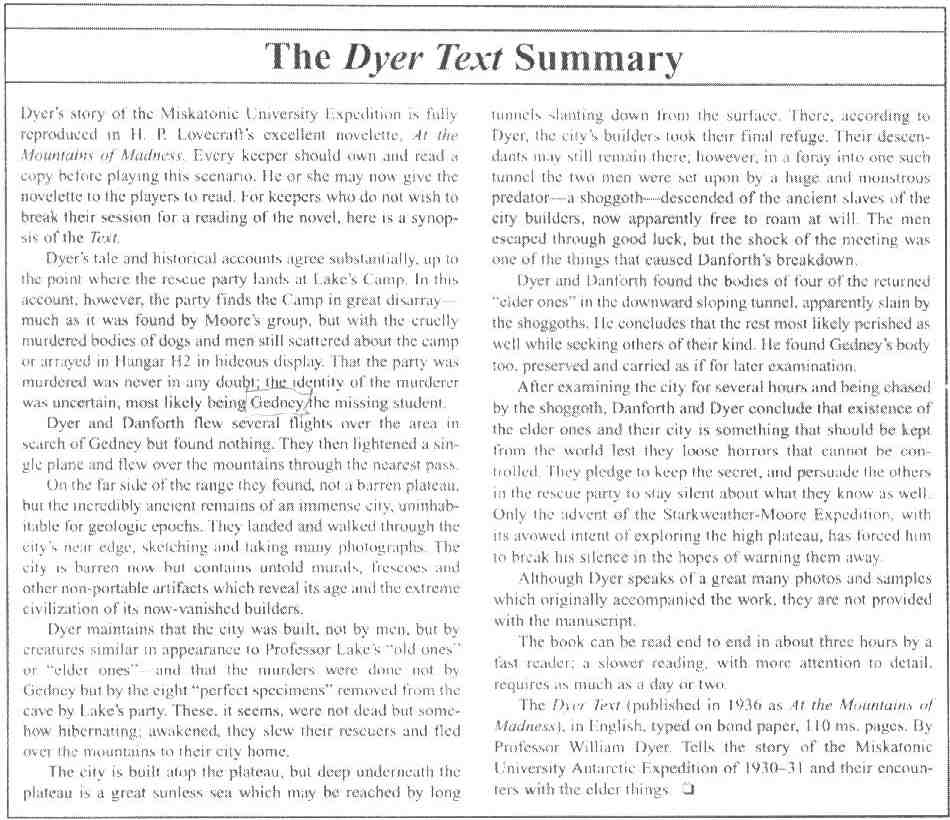At the Mountains 27th - 30th November 1933
The flight to the mountains was uncomfortable, the plane crowded and noisy with the whine of the engines. After some hours, the expedition approached the foothills of the dark, brooding mountain range and the search for Lakes camp began. After some searching, Professor Caine spotted some features on the ice below which appeared to be too regular to be natural and the plane landed.The first day was spent preparing their camp to the north west of Lakes camp, setting up tents (with varying degrees of success) and protecting the structures they erected from the constant wind coming off the mountain range. Over the next few days, the party began to investigate the remains of Lakes camp, their progress hampered by the layers of ice and snow that had built up on the structures the fleeing group had left behind and by the fragility of some of those structures, as Shuttlebolt and Ivanoff discovered when they fell through one of the mounds.
They started with a quick inspection of the site and soon worked out where the tents had been left. They also found their interest drawn to a set of low mounds, roughly aligned to the south pole.
Locations so far checked:
Tent 3: The tent flap has been almost torn off and the contents are gone. Careful examination finds a notebook, its pages ripped out, with Ex Libris George Gedney written on the spine.
Tent 4: This tent is full of spoiled food. Inspection reveals that opened tins of beef and pemmican have been torn open by brute force, rather than in a conventional way.
Tent 9: This tent appears to have been the scene of live dissections. Strange footprints are found in the blood all over the ground which match to the strange bodies found in the hummocks.
Hummock 1: Contains the torso of some sort of creature, which has been crudely dissected.
Hummock 2: Contains another torso, with a partial, star-shaped end.
Hummock 3: Contains a star shaped stone, covered in minute stippled dots. Shuttlebolts experiments with this have indicated that the dogs become aggressive to anyone carrying one of these stones.
Hummock 4: As hummock 3.
Hummock 5: As hummock 3.
Hummock 6: As hummock 3.
Dog corral: An entire day of effort on his own by Ivanoff uncovered a gruesome scene (which nearly drove him mad). Several of the dogs have been butchered. Many have died from frightful wounds, others from strangulation. Two have been skinned and their muscles removed, one has had its brain removed and four have no organs left. Another dog is in small pieces, scattered among the other remains.
Hangar 1: Contains the wreckage of a plane, which has had some components removed.
Hangar 2: Not opened yet, apart from the partial collapse of the roof where Shuttlebolt and Ivanoff fell through it.
Hangar 4: Empty.
Remaining locations:
Tent 1:
Tent 2:
Tent 5:
Tent 6:
Tent 7:
Tent 8:
Hangar 2:
Cairn:
Dig site:
Balance of Power, 1 - 3rd December 1933
At about 4.30 in the morning on the 1st of December, a plane arrived at the camp, containing members of the Barmeier-Falken Expedition (BFE), who announced that they had decided to investigate Lakes camp as well. They immediately began to set up camp, as an air of tension permeated the area, with several members of all three expeditions now carrying guns, some more concealed than others. The investigation of Lakes camp continues.Shuttlebolt stayed up the night, acting as guide (and overseer) as the German party commenced their research of Lakes camp. He soon observed that they were meticulous in their approach, noting each item they found, photographing it and creating an archeological map of the camp. They also, for some reason, cut probe holes into the hangars, carefully marking each one. As morning approached, Shuttlebolt gave in to exhaustion and went to bed.
In the morning, the Professor Meyer approached Moore and invited him to the grand opening of an area of great interest. Intrigued, Moore and the investigators joined him as he went to hangar 2. The hangar was soon opened and a vision of mute horror greeted all. The tent had obviously been used as a dissection chamber for dogs, with various dissected organs arranged neatly around the floor. They soon noticed that where each dog corpse had lain, there was a ring of salted snow, which lead to the realization that their were also human sized rings of salt on the floor, with distressing implications. Meyer turned to Moore, telling him that there was something important he must give him and they departed, closely shadowed by Professor Caine. Meyer gave Moore a book and, in a scene which was to be repeated a great deal in the day, Caine made strenuous efforts to find out what it was.
At noon, Moore had read the manuscript given to him by Meyer and called the investigators to his tent to tell them what it was (and to stop Caine badgering him ). He explained that it was an account by Dyer of the 1930s expedition which was so fantastical that he could barely believe it, despite Dyer having been a trusted friend of his. It told of a city in the mountains and of horrors from another age, monsters beyond reason. He asked the investigators to read it and make up their own minds, then rejoin him in his tent to discuss what their next step should be. Caine readily agreed.

They rejoined Moore that evening, after a briefing on the text (and how completely untrustworthy, unscientific and preposterous it all was) with Caine. A decision was taken to investigate the validity of the text by flying through the mountain pass to see if the city truly existed. Over the next day or so, preparations were made, including the discovery of tainted Oxygen tanks, still usable but with some risk of nausea.
At 4.30am on the 4th, Starkweather arrived, in a fearful bate. He gave an impromptu speech to all expedition members, regarding the importance of not letting the Huns get anywhere first, particularly with 'that damned woman'. The preparations continued through the night. The investigators took the chance to visit the dig site, a site of incredible archaeological and paleontological interest, at least to Professor Moore. At about 10.20am on the morning of the 4th, the Belle (Lexington's plane) took off, with help from the BFE. Shortly after, the Weddell and the Enderby finally got airborne and set off in to the mountains.
